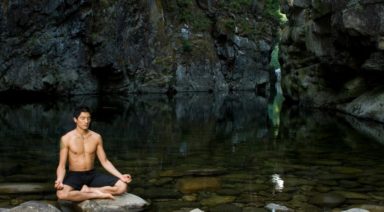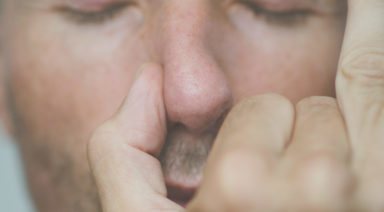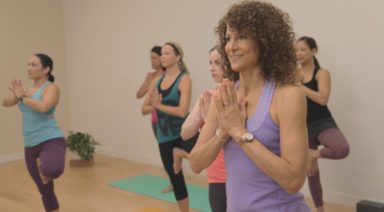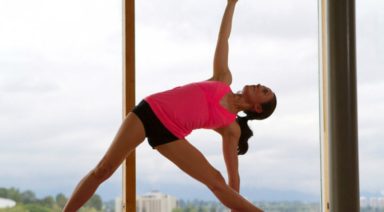How to Unite Body and Mind With Conscious Breath

“Feelings come and go like clouds in a windy sky. Conscious breathing is my anchor.”
As explained by the Vietnamese Zen Master, Thich Nhat Hanh, the breath is the key for calming us down, and bringing us back to our own center. In yoga, we believe that by creating a deep connection with ourselves, through conscious breath, we can achieve domain over ourselves. As you move in a yoga class, as you listen to the teachings and as you relax your breath — paying attention to what keeps you alive — you start the journey back home. You return to your peace and the ultimate nature of your mind.
Another wonderful yoga master, B.K.S. Iyengar, explains that yoga is an ancient but perfect science that deals with the evolution of humanity. This evolution includes all aspects of ones being, from bodily health to self-realization.
Yoga means union – the union of body with consciousness, and consciousness with the soul. Yoga can help you to maintain a balanced attitude in day-to-day life, and will endow you with skills you can use in the performance of many types of actions. When you do the yoga postures, you may reveal to yourself where you are resisting your natural state so that you can release and relax. It sounds complex, but at the same time it’s simple: you just need to start breathing and moving. Yoga is the balancing and joining together of our energy, mind and body.
If you’ve never tried yoga before, just one class will open you up to the different ways to experience stability, develop control over your emotions, gain more physical stamina, become more intuitive, focus and hopefully become more balanced in different situations in your daily life.
Give it a try, and see how your life will improve!
Pranayama for Health and Vitality

What Is Prana?
Prana is the sum total of all energy that is manifested in the universe. It is the vital force, Sukshma. Breath is the external manifestation of Prana. By exercising control over this gross breath, you can control the subtle Prana inside. Control of Prana means control of mind. Mind cannot operate without the help of Prana. It is the Sukshma Prana that is intimately connected with the mind. Prana is the sum total of all latent forces which are hidden in men and which lie everywhere around us. Heat, light, electricity, magnetism are all the manifestations of Prana. Prana is related to mind; through mind to the will; through will to the individual soul, and through this to the Supreme Being.
The seat of Prana is the heart. Prana is one; but it has many functions to do. Hence it assumes five names according to the different functions it performs, viz., Prana, Apana, Samana, Udana and Vyana. According to the different functions they perform, they occupy certain places in the body.
Breath directed by thought under the control of the will is a vitalising, regenerated force which can be utilised consciously for self-development, for healing many incurable diseases and for many other useful purposes. Hatha Yogins consider that Prana Tattva is superior to Manas Tattva (mind), as Prana is present even when mind is absent during deep sleep. Hence Prana plays a more vital part than mind.
If you know how to control the little waves of Prana working through mind, then the secret of subjugating the universal Prana will be known to you. The Yogin who becomes an expert in the knowledge of this secret, will have no fear from any power, because he has mastery over all manifestations of power in the Universe. What is commonly known as Power of Personality is nothing more than the natural capacity of a person to wield his Prana. Some people are more powerful in life, more influential and fascinating than others. It is all through this Prana, which the Yogin uses consciously by the command of his will.
Pranayama
Prana
Vital force, vitality, nourishment, upward flowing
Yama
Control
- Ujjayi (Victorious breath)
Sit comfortably, easily. Close the mouth. Inhale slowly through both the nostrils in a smooth, uniform manner.
Expand the chest when you inhale. During inhalation a peculiar sound is produced owing to the partial closing of glottis. The sound produced during inhalation should be of a mild and uniform pitch. It should be continuous also. This breath technique may be practised even when walking or standing – exhale slowly through both nostrils making the same sound.
Benefits: This removes the heat in the head. The practitioner becomes very beautiful. The gastric fire is increased. It removes phlegm in the throat. Asthma, snoring, beneficial for thyroid problems, consumption and all sorts of pulmonary diseases are cured. All diseases that arise from deficient inhalation of oxygen and diseases of the heart are cured. All works are accomplished by Ujjayi Pranayama. The practitioner is never attacked by diseases of phlegm, nerves, enlargement of spleen, dyspepsia, dysentery, consumption, cough or fever. Improves mental health and particularly the nervous system. Perform Ujjayi to destroy decay and death.
- Kapalabhati (the breath of fire or the skull shining breath, invigorating, energizing, and purifying)
Very active forced exhalations with a passive inhalation – while exhaling – quickly pump the belly into the back of the spine forcing the air out of the nose. Place one of your hands on your belly if you so wish in order to feel more the action. KEEP STEADY RHYTHM. Do 3 sets of 30 repetitions.
Avoid if under high medication for blood pressure, recent abdominal surgery/injury or pregnancy.
Benefits: Maintains good health and fights disease, nadis (nerves) of the brain get good exercise, regular practice (10-15 min daily) will aid in riding forehead of wrinkles, improves luster of skin, strengthens nerves and brain centers, massages internal organs.
- Bhastrika (Bellow’s breath)
Rapid sucession of forcible breaths. Sitting in Vajrasana (hero’s pose or kneeling), hands resting on your lap, palms facing upward. Take a few calming natural breaths to prepare. Bring your hands in a fist position by the side of your shoulders. – Inhale powerfully through the nose and raise your arms above your head with open hands, exhale forcefully as you bring your arms back to starting position, continue for the required amount of repetitions. On the last exhalation – follow it by a deep possible inhalation – breath is suspended for as long as it can be done with comfort, simultaneously: engage the lower bandhas (pelvic floor closes and belly button pulls back to back of the spine, both to 30% of max) follow it by a slow and deep possible, exhalation. – Rest for 5 deep normal breaths before starting again. – 3 sets.
Benefits: Relieves inflammation of the throat, increases gastric fire, removes disease of the nose, chest and eradicates asthama, it gives good appetite, breaks and dissolves tumors, wakes up kindalini energy, removes all diseases which arise from excess wind, bile and phlegm, gives warmth to the body, purifies the nadis considerably, useful in muscular dystrophy and oxygen deficiency disorders, it balances the 3 doshas, purifies the blood, helps to rid body of foreign intruders and toxins, stabilizes prana, calms the mind and nervous system.
- Shitali (The cooling breath)
Roll the tongue into a tube (as best as you can) and stick the tip of the tongue out of the mouth. Inhale through the tongue and hold the breath in for 4-5 seconds with the chin pressed against the chest. Exhale using Ujjayi Pranayama through the nose. Repeat 5-10 times.
Benefits: Lowers temperature of the body in the heat, quenches thirst,cures acidity, hypertension, skin diseases, removes impurities from the blood, improves overall fitness, brings a glow to the face.
Sound is the highest vibration of consciousness
Sound is carried through the bones of the human body.
Your consciousness is laying dormant at the bottom of your pelvic cavity (pelvic floor area) and in order to wake it up, one must use sound (vibration), movement and breath.
CHANT “OM” (oum) 3 TIMES AT THE BEGINNING OF YOUR PRANAYAMA EXERCISES.
OM: Universal/Primordial sound of everything, – It is the root of all mantras.
Mantras: Combination of Sanskrit words that have a soothing effect in the sympathetic system (stress response/ flight 2 flight response mechanism)

































